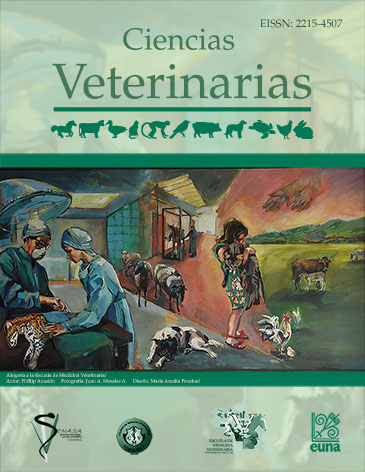Different cephalic development among rabbit types
DOI:
https://doi.org/10.15359/rcv.36-2.2Keywords:
“belier” rabbits, “toy” rabbit, gerontomorphy, Oryctolagus cuniculus, pedomorphyAbstract
The word “allometry” refers to the relative growth of a biological structure to other(s) or to the entire body, and encompasses conformational changes due to size change. When growth is the same among studied traits, it is known as “isometry”. In order to study this phenomenon in domestic rabbit, a sample of 71 fresh post-weaned rabbit corpses of different age was collected, and skulls were obtained and defleshed. Of this sample, 59 corpses were from companion type (“toys” and “beliers”) and 12 from meat type (Californian/New Zealand) rabbits. From each skull it was obtained a digital picture, on its lateral aspect, and 12 anatomical landmarks were situated on it and analysed by means of geometric morphometric methods. Meat rabbits presented a clear isometric growth, although they were still growing (e. g. have not reached to final growth stage) while companion rabbits presented a clear allometric growth (e. g. adults have not reached a final growth). So, it is illustrated a case of gerontomorphy for meat rabbits —e. g. an early development of skull traits— and a case of pedomorphy for companion rabbits —e. g. a delayed growth in skull traits in order to mantain typical juvenile traits as a short and plain face, and a comparatively big cranium—. In other words, for the former group, a precocious development was detected, while for the latter, it was detected a retention of juvenile traits, being for both types cases of developmental heterochronies.
References
Ávila, D. 2017. Variaciones alométricas durante el crecimiento en siete especies de Garzas (Aves: Ardeidae). Rev Biol Trop 65 (4): 1347–1357.
Bolstad, G.H., Cassara, J.A., Márquez, E., Hansen, T.F., van der Linde, K., Houle, D. & Pélabon, C. 2015. Complex constraints on allometry revealed by artificial Selection on the wing of Drosophila Melanogaster. Proc Natl Acad Sci U.S.A 112 (43): 13284–13289. Doi:10.1073/pnas.1505357112.
Cardini, A. & Polly, P.D. 2013. Larger mammals have longer faces because of size-related constraints on skull form. Nat Commun 4 (2458): 1–7. Doi:10.1038/ncomms3458.
Domínguez-Viveros, J., Rodríguez-Almeida, F.A., Núñez-Domínguez, R., Ramírez-Valverde, R., Ortega-Gutiérrez, J.A. & Ruiz-Flores, A. 2013. Ajuste de modelos no lineales y estimación de parámetros de crecimiento en bovinos tropicarne. Agrociencia 47 (1): 25–34.
Galán, C. 2010. Evolución de la fauna cavernícola: mecanismos y procesos que explican el origen de las especies troglobias. Bol Soc Venez Espeleol: 1–31.
Gould, S.J. 1966. Allometry and size in ontogeny and phylogeny. Biol Rev Camb Philos Soc 41 (4): 587–640. Doi:10.1111/j.1469-185X.1966.tb01624.x.
Hammer, Ø., Harper, D.A.T. & Ryan, P.D. 2001. PAST v. 2.17c. Palaeontol Electron 4 (1): 1–229.
Klingenberg, C.P. 2011. MorphoJ: An integrated software package for geometric morphometrics. Mol Ecol Resour 11 (2): 353–357. Doi:10.1111/j.1755-0998.2010.02924.x.
Klingenberg, C.P. 2016. Size, shape, and form: concepts of allometry in geometric morphometrics. Dev Genes Evol 226 (3): 113–137. Doi:10.1007/s00427-016-0539-2.
Mitteroecker, P., Gunz, P., Windhager, S. & Schaefer, K. 2013. A brief review of shape, form, and allometry in geometric morphometrics, with applications to human facial morphology. Hystrix 24 (1): 59–66. Doi: doi.org/10.4404/hystrix-24.1-6369
Parés-Casanova, P.M., Caballero-Sala, M. & Perezgrovas, R. 2016. Age changes in Chiapas sheep breed according to sex. Rev Investig Vet Peru 27 (4): 651-657. Doi:10.15381/rivep.v27i4.12642.
Rohlf, F.J. 2015. TpsSmall v. 1.33. http://life.bio.sunysb.edu/morph/. http://life.bio.sunysb.edu/morph/.
Rohlf, F.J. 2016. TpsDig v. 2.26. http://life.bio.sunysb.edu/morph/index.html. http://life.bio.sunysb.edu/morph/.
Toro Ibacache, M.V., Manriquez Soto, G. & Suazo Galdames, I. 2010. Morfometría geométrica y el estudio de las formas biológicas: de la morfología descriptiva a la morfología cuantitativa. Int J Morphol 28 (4): 977–990. Doi:10.4067/S0717-95022010000400001.
Voje, K.L., Hansen, T.F., Egset, C.K., Bolstad, G.H. & Pélabon, C. 2014. Allometric constraints and the evolution of allometry. Evolution 68 (3): 866–885. Doi:10.1111/evo.12312.
Downloads
Published
How to Cite
Issue
Section
License
Licensing of articles
All articles will be published under a license:

Licencia Creative Commons Atribución-NoComercial-SinDerivadas 3.0 Costa Rica.
Access to this journal is free of charge, only the article and the journal must be cited in full.
Intellectual property rights belong to the author. Once the article has been accepted for publication, the author assigns the reproduction rights to the Journal.
Ciencias Veterinarias Journal authorizes the printing of articles and photocopies for personal use. Also, the use for educational purposes is encouraged. Especially: institutions may create links to specific articles found in the journal's server in order to make up course packages, seminars or as instructional material.
The author may place a copy of the final version on his or her server, although it is recommended that a link be maintained to the journal's server where the original article is located.
Intellectual property violations are the responsibility of the author. The company or institution that provides access to the contents, either because it acts only as a transmitter of information (for example, Internet access providers) or because it offers public server services, is not responsible.







